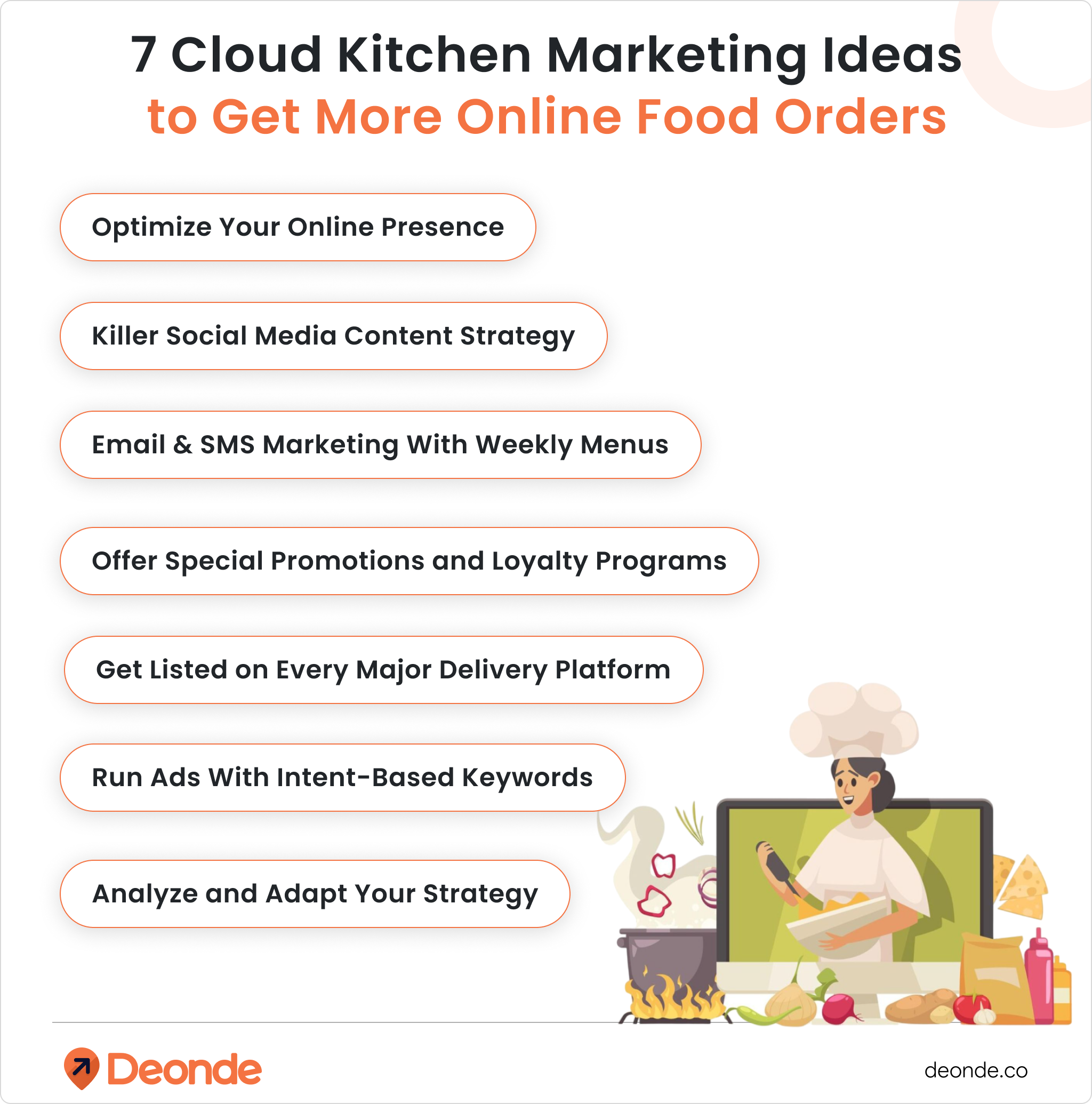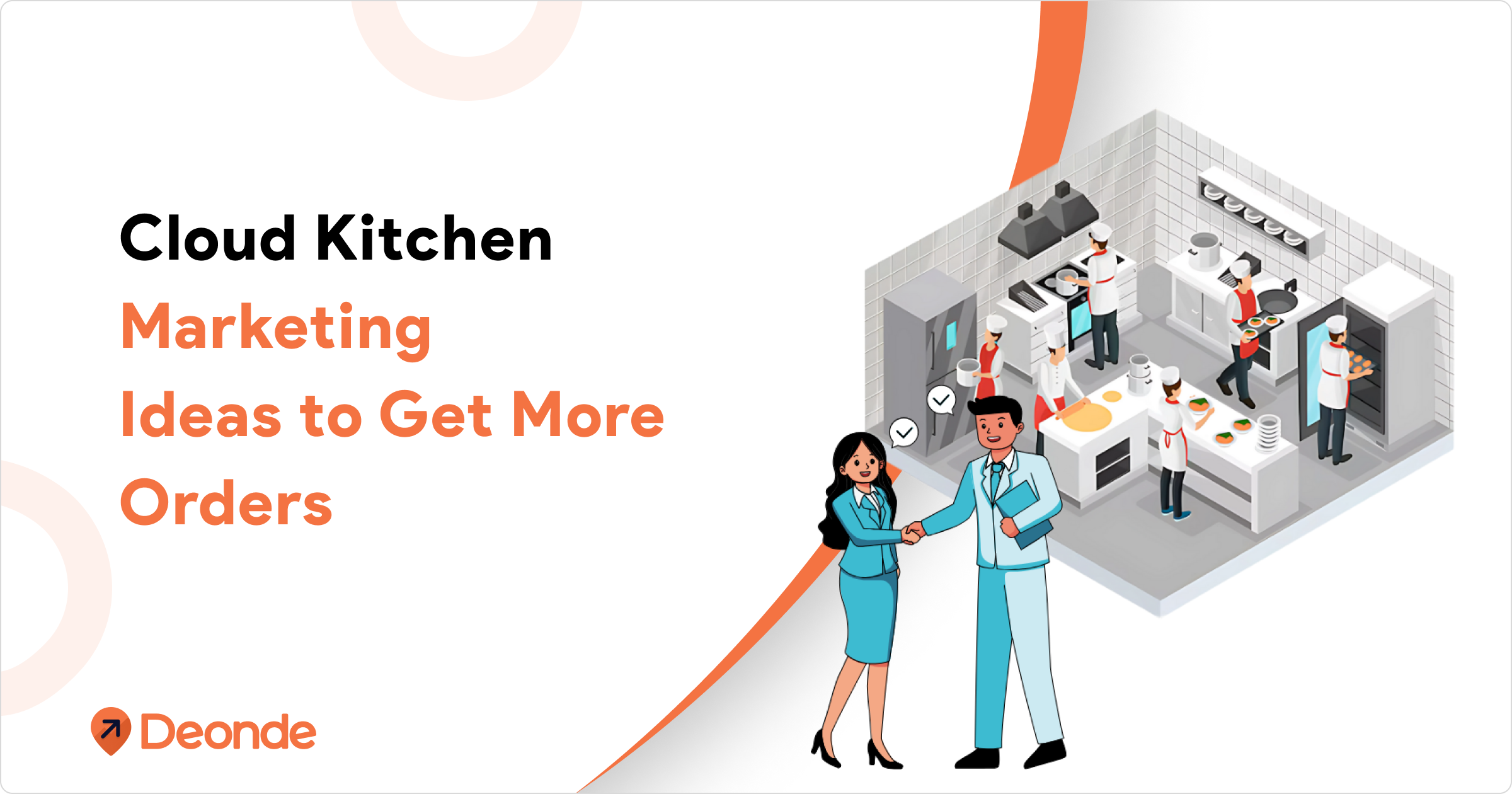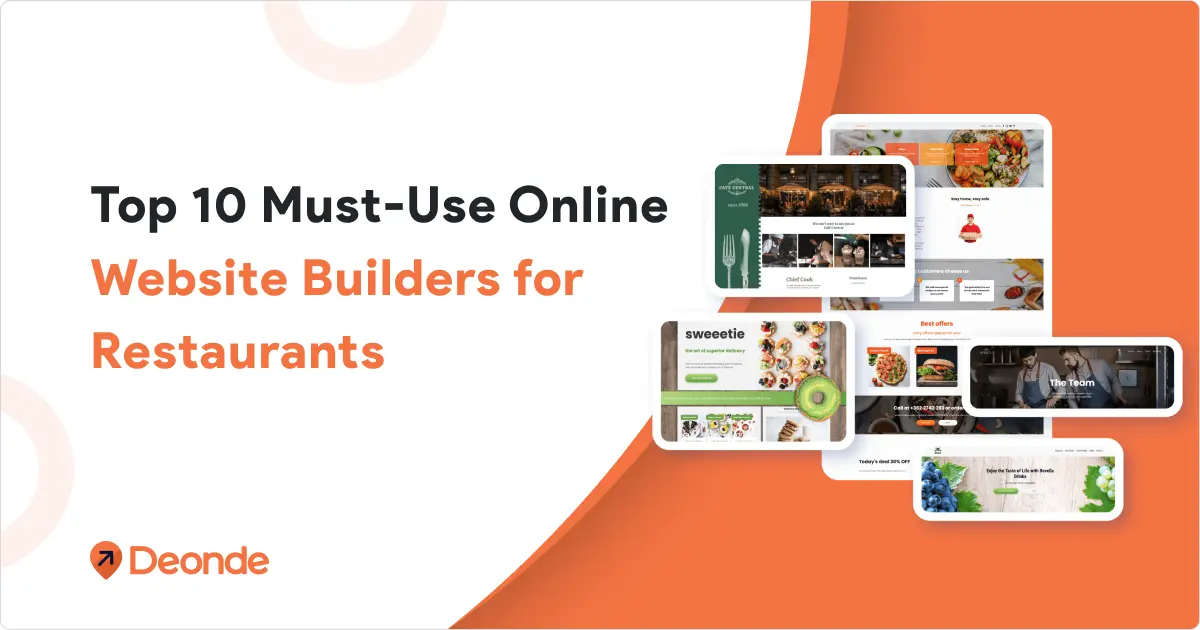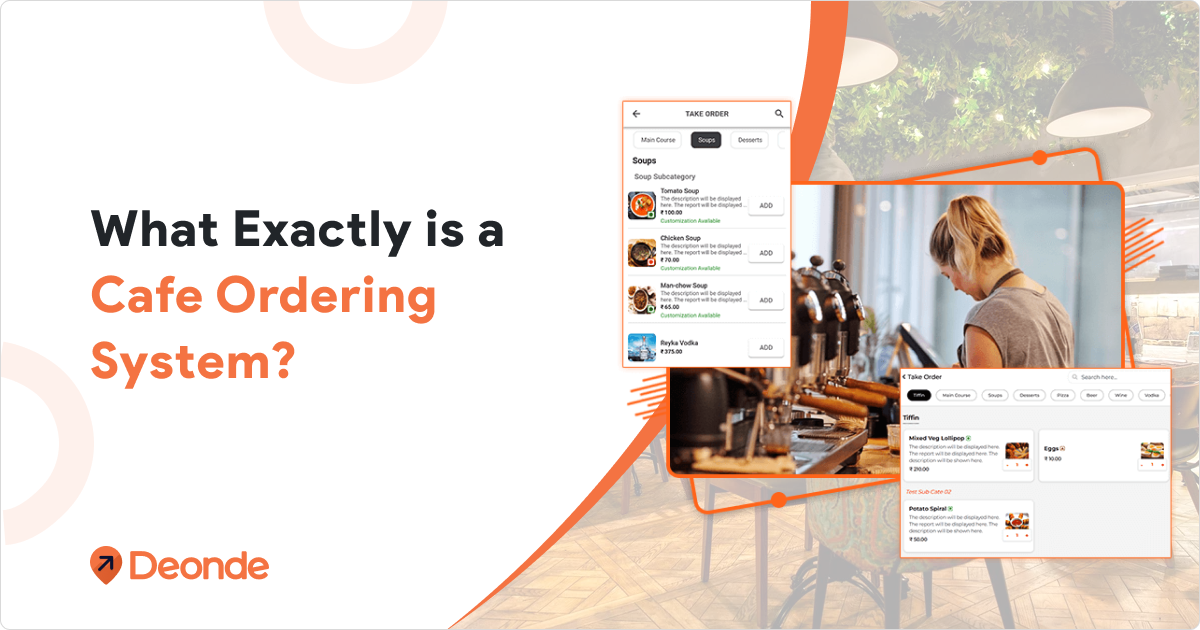Imagine running a kitchen where you cook tasty meals, pack them up, and send them straight to hungry customers—no dining room needed! That’s the magic of a cloud kitchen. But here’s the challenge: with no storefront for people to walk by, you need to get noticed online. Don’t worry! Cloud kitchen marketing ideas are here to help you attract customers and keep them coming back.
The food delivery world is growing fast—experts say it’ll be worth $1.4 trillion by 2027. Whether you’re new to running a cloud kitchen or want to take yours to the next level, these 10 cloud kitchen marketing ideas are super easy to understand and apply. this guide is perfect for anyone looking to grow their cloud kitchen business growth. From creating a fun brand to posting on social media, let’s make your kitchen a customer favorite in 2025!
What Is a Cloud Kitchen?
Before diving into marketing, let’s clarify what a cloud kitchen is. A cloud kitchen (or ghost kitchen) is a food business that skips the traditional restaurant setup. Instead of a dining room, it’s just a professional kitchen focused on making meals for online orders, delivered through apps like UberEats, DoorDash, or Zomato. Picture a busy kitchen in a warehouse churning out pizzas, tacos, or sushi for delivery or takeout.
Here’s why cloud kitchens are awesome:
- Low Costs: No need for fancy decor or waitstaff, so you save money to focus on great food.
- Online-Only: Orders come through delivery apps or your website, making digital marketing your superpower.
- Flexible Menus: You can run multiple cuisines or brands from one kitchen, like offering burgers and vegan bowls under different names.
- Scalable: Start small and grow as orders increase, perfect for new food entrepreneurs.
Cloud kitchens are a smart way to jump into the food industry, but since customers can’t walk by and see you, cloud kitchen marketing ideas are key to getting noticed.
7 Cloud Kitchen Marketing Ideas to Get More Online Food Orders

1. Optimize Your Online Presence: Your Digital Doorway
Think of your online presence as your first impression on potential customers. It needs to be welcoming, informative, and easy to navigate, just like a well-organized physical restaurant (without the physical!).
User-Friendly Website & App
Ensure your website and app (if you have one) are functional and visually appealing. Use high-quality photos of your dishes that look universally tempting. Clearly display your menu with accurate pricing in relevant currencies (or with a currency converter). Prominently feature your delivery radius and any specific delivery charges for different zones. Make online ordering seamless and secure, with popular payment options integrated.
Optimize Your Business Profile
Ensure your online business profiles (like Google’s business listing) are fully optimized. Maintain accurate name, address (if applicable), phone number, and service areas. Update operating hours, showcase high-quality photos, actively manage customer reviews, and post regular updates. Use relevant keywords for your cuisine and delivery services.
SEO Integration
Optimize your website content with keywords that potential customers might use when searching for food delivery. Think beyond generic terms and include phrases like “best [cuisine] delivery online,” “order food online near me,” or “authentic [cuisine] food online.” Ensure your website is mobile-friendly and loads quickly. Consider multilingual options if you serve diverse regions. Learn more about building a strong online food ordering system.
2. Killer Social Media Content Strategy: Engaging the Foodie
Social media is your direct line to hungry customers. Your content needs to be more than just pretty pictures; it needs to resonate with diverse tastes and preferences.
Visually Stunning Food Photography & Videography: Invest in high-quality visuals that make your food look irresistible. Showcase the freshness of ingredients and the care in your preparation. Short, engaging videos showcasing the cooking process or plating can be very effective.
Universally Relevant Captions & Stories: Use broadly understood language and avoid overly localized slang or references. Focus on the appeal of your food – taste, quality, convenience. Highlight the cultural origins or inspirations behind your dishes.
Interactive Content & Engagement:
- Polls & Quizzes: Ask about favorite cuisines or food preferences.
- Contests & Giveaways: Run contests with appealing prizes, like a free meal or a discount code.
- Behind-the-Scenes: Share glimpses of your kitchen, emphasizing hygiene and quality standards.
- User-Generated Content: Encourage customers to share photos of their orders using a unique hashtag. Repost their content to build community and social proof.
Targeted Social Media Ads: Utilize advertising features on relevant platforms to reach specific demographics, interests (food lovers, specific cuisines), and geographic locations you serve. Run campaigns highlighting special offers or new menu items.
3. Email & SMS Marketing With Weekly Menus: Reaching Your Customer Base Directly
Email and SMS marketing are powerful tools for direct communication with your existing and potential customers.
Build a Contact List: Encourage sign-ups through your website, app, and even on your delivery packaging (QR codes). Offer appealing incentives for subscribing, like a discount on their first order. Ensure compliance with data privacy regulations.
Regular Menu & Special Offers: Send out regular emails and SMS messages featuring your menu highlights, including any new dishes or special promotions. Highlight seasonal ingredients or globally recognized food holidays.
Personalized Communication: Segment your list based on past order history and preferences. If a customer frequently orders a specific cuisine, highlight similar dishes in your communication to them. Acknowledge relevant holidays or events.
Timely Updates & Reminders: Use SMS for quick updates on delivery status. Send email reminders for recurring promotions or upcoming menu changes.
Feedback Collection: Use email and SMS to solicit feedback on recent orders, allowing you to understand preferences and improve your offerings. Check out Customer Satisfaction Strategies for Food Delivery Services
4. Run Ads With Intent-Based Keywords: Capturing Cravings
Advertising is crucial for reaching new customers who are actively searching for food delivery. Focusing on intent-based keywords ensures you’re connecting with those ready to order.
Search Engine Ads: Target keywords that indicate a strong intent to order food in the regions you serve, such as:
- “[Cuisine] delivery in [location]”
- “Best [dish] online”
- “Order food online near me”
- “Food delivery open now”
- “Vegetarian food delivery” (if applicable)
- Utilize location extensions to show your delivery area within specific regions.
Social Media Ads with Purchase Intent: Target users on relevant platforms who have shown interest in food delivery, restaurants, or specific cuisines you offer. Utilize call-to-action buttons like “Order Now” or “See Menu.”
Remarketing Campaigns: Target users who have visited your website or app but haven’t placed an order. Remind them of your delicious food with compelling visuals and special offers.
5. Get Listed on Every Major Delivery Platform: Maximize Your Reach
Delivery platforms are a primary source of orders for cloud kitchens. Being present on all popular platforms in the regions you serve is essential.
Identify Key Platforms: Research the most popular food delivery aggregators in each of your target markets. Ensure your listings are accurate, complete, and visually appealing on each platform.
Optimize Your Listings: Use high-quality photos and compelling descriptions for your dishes that translate well across cultures. Ensure your pricing is consistent across platforms (or strategically adjusted for different markets). Clearly mention your delivery areas within each region.
Platform-Specific Promotions: Explore running exclusive promotions or discounts specifically for users ordering through certain platforms in different regions.
Actively Manage Reviews: Monitor and respond to customer reviews on all platforms, regardless of location. Address any concerns promptly and professionally. Positive reviews build trust.
Track Performance: Regularly analyze your performance on each platform in each region to understand which ones drive the most orders and adjust your strategy accordingly.
6. Offer Special Promotions and Loyalty Programs: Enticing and Retaining Customers
Promotions and loyalty programs attract new customers and encourage repeat business.
New Customer Offers: Offer new customers a special discount or free item on the first order.
Loyalty Programs: Implement a points-based system or exclusive perks for repeat customers. Consider offering rewards that have universal appeal.
Bundle Deals & Combo Offers: Create attractive combo meals or bundle deals that offer value for money, considering popular pairings in different regions.
Limited-Time Offers & Themed Promotions: Introduce time-sensitive promotions around globally recognized holidays or events. Offer special menus or discounts during these periods.
Referral Programs: Encourage existing customers to refer friends by offering rewards for both the referrer and the referred friend.
7. Analyze and Adapt Your Strategy: Staying Ahead
The food delivery landscape is constantly evolving. Continuous analysis and adaptation are key to long-term success.
Track Key Metrics: Monitor your website traffic from different regions, social media engagement across platforms, email open/click-through rates globally, conversion rates, customer acquisition cost per region, and order volume and customer retention rates worldwide.
Utilize Analytics Tools: Leverage website analytics, social media analytics, and the analytics dashboards provided by delivery platforms.
A/B Testing: Experiment with different marketing messages, creatives, and offers across different regions to see what performs best.
Gather Customer Feedback: Actively solicit customer feedback through surveys, reviews, and social media interactions. Understand regional preferences and needs.
Stay Updated on Food Trends: Monitor the latest food trends and popular dishes to ensure your menu and marketing remain relevant across cultures.
Competitive Analysis: Monitor what your competitors are doing in terms of marketing and promotions in the regions you serve. Identify opportunities to differentiate yourself.
Conclusion
Getting more orders for your cloud kitchen is all about combining smart marketing with a seamless customer experience. By implementing these 10 cloud kitchen marketing ideas—from SEO and social media to influencer partnerships and loyalty programs—you can attract new customers, retain existing ones, and grow your business. Deonde’s all-in-one platform makes it easier than ever to execute these strategies, with features like branded apps, analytics, and automated marketing tools.
Ready to take your cloud kitchen to new heights? Start with Deonde’s white-label solutions and launch your online ordering system in just a week. Visit deonde.co to explore how we can help you scale your food delivery business and turn your cloud kitchen into a customer favorite.






